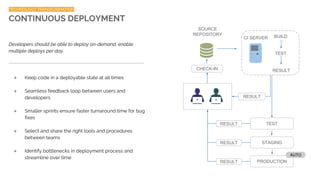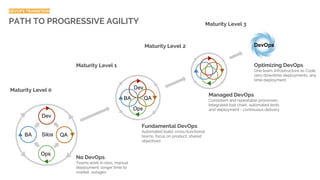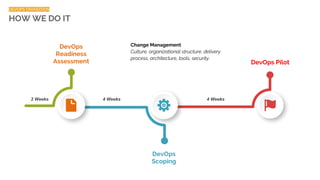DevOps Transformation: Learnings and Best Practices
- 1. DevOps Transformation LEARNINGS & BEST PRACTICES FOR ENTERPRISE DEVOPS TRANSFORMATION USA | UK | UAE | India | Singapore | Japan | Australia
- 2. INTRODUCTION DEV OPS ★ An approach based on agile and lean principles ★ Provides a path to faster delivery of software without compromising on reliability or security ★ Improves delivery flow, reduces lead time, and improves acceptance ratio during handoffs ★ Enables cross-functional collaboration within value streams DEVOPS TRANSFORMATION
- 3. WHY DEVOPS? Iterative Processes that enable iterative delivery, built-in reviews and in-process testing Collaboration Enhanced collaboration and integration between developers, QA, and IT Operations Automation Tools to automate activities such as development, testing, and deployment. Continuous Integration Frequent merging of code into a shared repository to detect problems early. Quantification Gauge improvement of processes by tracking KPIs such as deployment frequency, failures, and lead time Version Control Applying version code not just to source code, but to configurations and environment Holistic Holistic approach to agile — covers all processes related to development, testing, and deployment. DEVOPS TRANSFORMATION
- 4. © 2018 QBurst Technologies Pvt. Ltd. | Confidential and Proprietary© 2019 QBurst Technologies Pvt. Ltd. | Confidential and Proprietary CULTURAL TRANSFORMATION
- 5. PREREQUISITES FOR DEVOPS TRANSFORMATION ● Organizational culture and strategy ○ Readiness for change, buy-in from senior management, focus on innovation, coordination between teams, existing skill-sets and ramp-up challenges, customer focus ● Organizational structure ○ Willingness to standardize and break down silos that exist within processes and line of businesses CULTURAL TRANSFORMATION
- 6. CULTURAL TRANSFORMATION EVALUATING THE ORGANIZATIONAL ARCHETYPES Functional ● Hierarchically divided into smaller groups with specific tasks or roles ● Optimized for skills, labor division, and cost-reduction Market-oriented ● Flat organization with resources fully dedicated to common project activities ● Optimize for delivering value to customers Matrix ● Hybrid organizational structure with functional divisions ● Attempts to combine both Functional and Market orientations Your existing organisational structure may work with a few changes ● Move toward market-orientation by embedding functional engineers (QA, Infosec, Ops) into each service team ● Restructure service delivery cycle with DevOps automation in mind ● Embrace a culture of communication and collaboration throughout the organization ● Identify opportunities where automation can bring about efficiency and productivity
- 7. © 2018 QBurst Technologies Pvt. Ltd. | Confidential and Proprietary© 2019 QBurst Technologies Pvt. Ltd. | Confidential and Proprietary PROCESS TRANSFORMATION
- 8. VALUE STREAM MAPPING PROCESS TRANSFORMATION Current state baseline — capture performance metrics on existing development lifecycle Make work visible (for example, by using a Kanban board) Set future state targets Use results to create a compelling case for change Advantages ● Identify bottlenecks ● Improve visibility and traceability ● Eliminate redundant and wasteful processes ● Identify opportunities for automation ● Bring process clarity with data and visuals ● Highlight results and KPIs
- 9. DEVOPS TRANSFORMATION: PHASED APPROACH DEVOPS TRANSFORMATION ● Assess current state of Dev and Ops ● Gap analysis - Identify opportunities for automation ● Identify challenges in build, deployment and release management ASSESS ● Standardize governance structure and processes ● Automate build, release, and deployment ● Establish program governance - communication plan, set KPIs ● Initiate pilots IMPLEMENT ● Monitor adherence to SLAs and KPIs ● Implement continuous improvement plans and governance models MAINTAIN
- 10. © 2018 QBurst Technologies Pvt. Ltd. | Confidential and Proprietary© 2019 QBurst Technologies Pvt. Ltd. | Confidential and Proprietary TECHNOLOGY TRANSFORMATION
- 11. SOFTWARE ARCHITECTURE - MOVING FROM REACTIVE TO SCALABLE Architecture should be sufficiently decoupled, so work can be done without excessive coordination and communication — Microservices architecture is ideal for decoupling TECHNOLOGY TRANSFORMATION Transition to containers — lightweight compared to VMs Launch multiple containers in minutes Flexible cloud services to increase or decrease infrastructure based on requirement Reduced CAPEX planning; pricing based on use ARCHITECTURE PACKAGING INFRASTRUCTURE N-tiered Decoupled Microservices VM Containers Hosted Cloud AGILE DEVOPS
- 12. VERSION CONTROL ● Standardize coding practices ● Keep a log and view changes ● Enables team to carry out development in parallel ● Faster debugging of deployment failures and production issues ● Infrastructure as Code: Anyone can create an environment using information from source control DEVOPS TRANSFORMATION ● Code as well as infrastructure should be version controlled ● Operations-related artifacts ● Source code, automation scripts, deployment scripts, installation environment definition, infrastructure configuration and documents ● Version controlling tools ○ View difference between versions ○ Single source of truth WHY? WHAT? HOW?
- 13. CONTINUOUS INTEGRATION TECHNOLOGY TRANSFORMATION Integrating becomes exponentially difficult with an increase in branches or the number of changes in each branch. ● Merging into trunk should be part of everyone’s daily work ● Create a comprehensive automated test suite: Automated tests to be written for new features, enhancements, and bug fixes ● Integrate in smaller batches ● Run locally before committing to CI server BUILD TEST RESULT CI SERVER SOURCE REPOSITORY CHECK-IN RESULT
- 14. AUTOMATED TESTING - BEST PRACTICES DEVOPS TRANSFORMATION ✓ Code checked into version control must be automatically built and tested in a production-like environment ✓ Unit tests, acceptance tests, integration tests can be automated ✓ Unit and acceptance tests should run quickly ─ running them in parallel is recommended ✓ Automated testing on developer workstation can provide faster feedback ✓ Non-functional tests such as performance testing and security testing should be automated ✓ Automated tests should be reliable — false positives and unreliable tests create more problems than they solve ✓ A small number of reliable tests is better than a large number of unreliable tests Start by building a small suite of reliable automated tests and expand coverage over time.
- 15. DEPLOYMENT PIPELINE ● Utilize visualization tools to monitor pipeline and ensure green-build state ● Create a virtual Andon Cord ○ If a change that causes build to fail is introduced, no new work should be accepted until the problem is fixed ○ Notify testers and developers when a problem needs to be fixed ● Static code analysis, duplication/test coverage analysis, and checking style ● Ensure staging environment is identical to production environment ● Some tools can be run from IDE or during pre-commit (via pre-commit hooks) to enable faster feedback ● Create containers as part of the build process DEVOPS TRANSFORMATION
- 16. CONTINUOUS DEPLOYMENT TECHNOLOGY TRANSFORMATION Developers should be able to deploy on-demand, enable multiple deploys per day. ● Keep code in a deployable state at all times ● Seamless feedback loop between users and developers ● Smaller sprints ensure faster turnaround time for bug fixes ● Select and share the right tools and procedures between teams ● Identify bottlenecks in deployment process and streamline over time BUILD TEST RESULT CI SERVER CHECK-IN SOURCE REPOSITORY TEST STAGING PRODUCTION AUTO RESULT RESULT RESULT RESULT
- 17. DEPLOYMENT STRATEGIES: INFRASTRUCTURE-BASED DEVOPS TRANSFORMATION Blue-Green Deployment Canary Release ● Monitors critical system metrics when a new version is rolled out in a canary release. ● Automatically rolls back the deployment in case of high stats Cluster Immune System ● Incrementally upgrade to the latest version ● First build can go to employees, then to a larger group, and finally to everyone ● If a problem is discovered in an early stage, build goes no further ● Deploy complete application components, services twice ● Old version in blue and new version in green side by side ● To cut over to the new version and roll back to old, change the load balancer or router setting
- 18. DEPLOYMENT STRATEGIES: APPLICATION-BASED DEVOPS TRANSFORMATION Feature Toggles Dark Launches ● Releasing production-ready features to a subset of users first ● Helps get real user feedback, test for bugs, and assess infrastructure performance ● In case something goes wrong during deployment, it’s easy to roll back the changes and fix the problem with the old infrastructure/code still in place, ● Control who can access a new feature to test a feature on production with a select group of users. ● Implement a toggle router to dynamically control which code path is live ● Toggle Router can make decisions based on environment-specific configurations ● Helps release near bug-free features
- 19. ENVIRONMENT: DOS & DON’TS Developers should have the ability to create production-like environments on-demand. Automate environment creation process. This applies to development, testing, and production environments. Utilize tools such as chef to automatically configure newly provisioned environments. DEVOPS TRANSFORMATION Inconsistently constructed environments and not putting changes back to version control can create problems. Immutable infrastructure - manual changes to production environment are not allowed. Make infrastructure easier to build than repair. Entire application stack and environment can be bundled into containers. Package applications into deployable containers. Verify that the application runs as expected in a production-like environment before the end of a sprint.
- 20. MONITORING ● Have an integrated monitoring system for Dev and Ops ● Move all monitored data to a central location ● Derive metrics from monitored data ○ Plot metrics as graphs ○ Display deployment events on the same graph to correlate problems with deployments ○ Statistically analyze collected metrics to identify deviations. Example: Generate an alert if the metric (e.g. page load time) is 3 standard-deviations away from the mean (this assumes the metric has a Gaussian distribution) ✓ Another strategy is outlier identification Example: In a cluster of thousands of nodes, if the performance metrics of a node deviates from the normal, it can be taken down ● Alerts: Generate alerts only for indicators that predict outages. Too many alerts could cause alert fatigue. ● Anomaly detection: Use statistical tools (Excel, SPSS, SAS, R etc.) on datasets to find anomalies. Example: If orders fall below 50% of the normal (expected number of orders based on historical trend) on Wednesday morning ● Kolmogorov-Smirnov test: Find similarities/differences in seasonal/periodic data DEVOPS TRANSFORMATION What should be monitored? End-to-end monitoring of the entire software stack is essential. ● Applications ● Databases ● Servers and networks ● Builds ● Automated tests ● Deployments ● All environments (development, testing, staging, production) Tools Graphite | Grafana | Nagios
- 21. © 2018 QBurst Technologies Pvt. Ltd. | Confidential and Proprietary© 2019 QBurst Technologies Pvt. Ltd. | Confidential and Proprietary ADOPTION OF TOOLS
- 22. TOOLS DEVOPS TRANSFORMATION SCM SECURITY COLLABORATIONINFRA & CONFIG MANAGEMENT LOG TEST CI/CD MONITORCONTAINERIZATION
- 23. © 2018 QBurst Technologies Pvt. Ltd. | Confidential and Proprietary© 2019 QBurst Technologies Pvt. Ltd. | Confidential and Proprietary TRANSITION
- 24. Dev SilosBA QA Ops Dev BA QA Ops DevOps Maturity Level 0 Maturity Level 1 Maturity Level 2 Maturity Level 3 No DevOps Teams work in silos, manual deployment, longer time to market, outages Fundamental DevOps Automated build, cross-functional teams, focus on product, shared objectives Managed DevOps Consistent and repeatable processes, Integrated tool chain, automated tests and deployment - continuous delivery Optimizing DevOps One team, Infrastructure as Code, zero downtime deployments, any time deployment PATH TO PROGRESSIVE AGILITY DEVOPS TRANSITION
- 25. HOW WE DO IT 2 Weeks DevOps Readiness Assessment DevOps Scoping 4 Weeks 4 Weeks DevOps Pilot Change Management Culture, organizational structure, delivery process, architecture, tools, security. DEVOPS TRANSITION
- 26. 14150 Newbrook Drive Suite 115 Chantilly, VA 20151, USA www.qburst.com


























